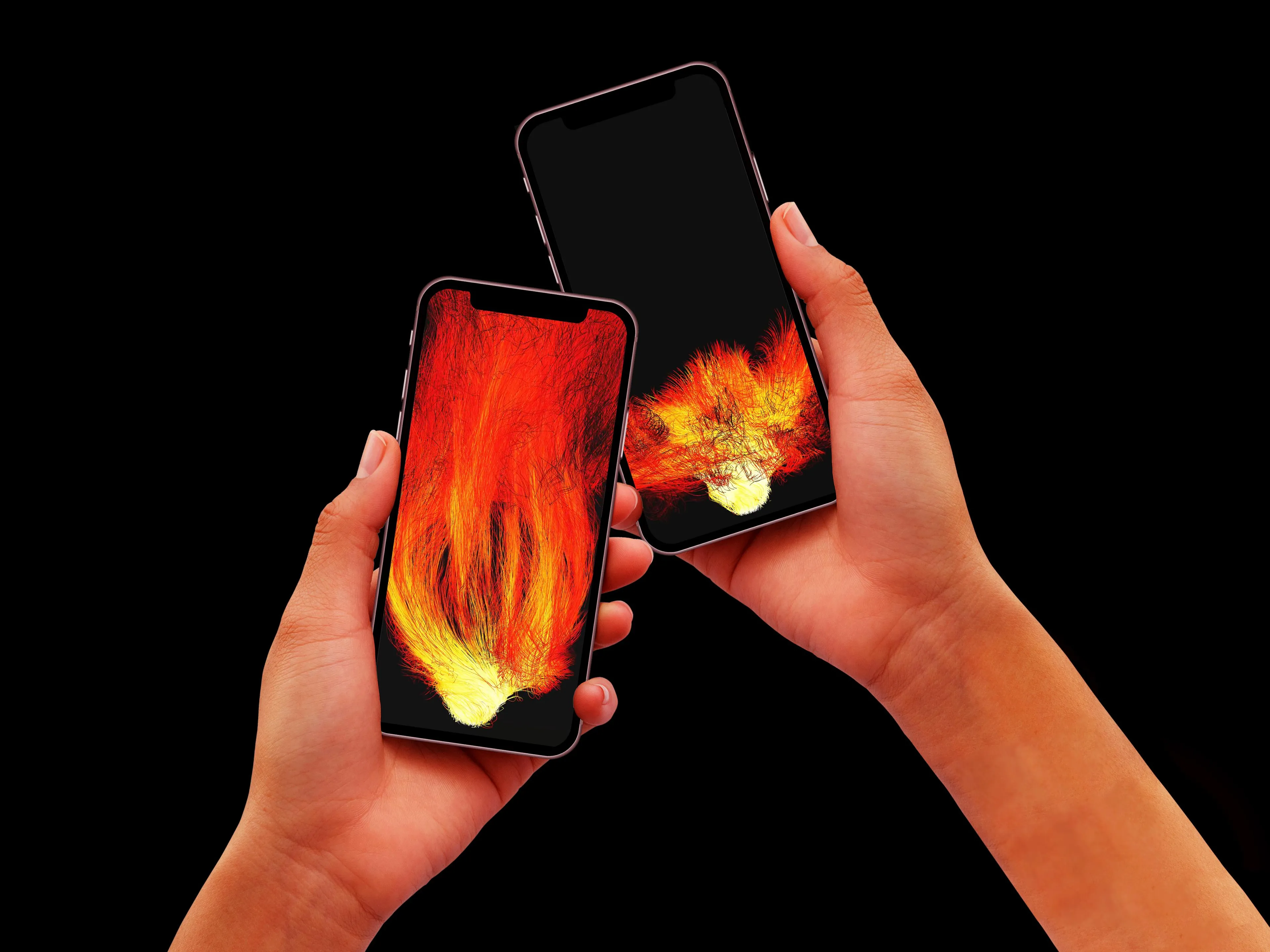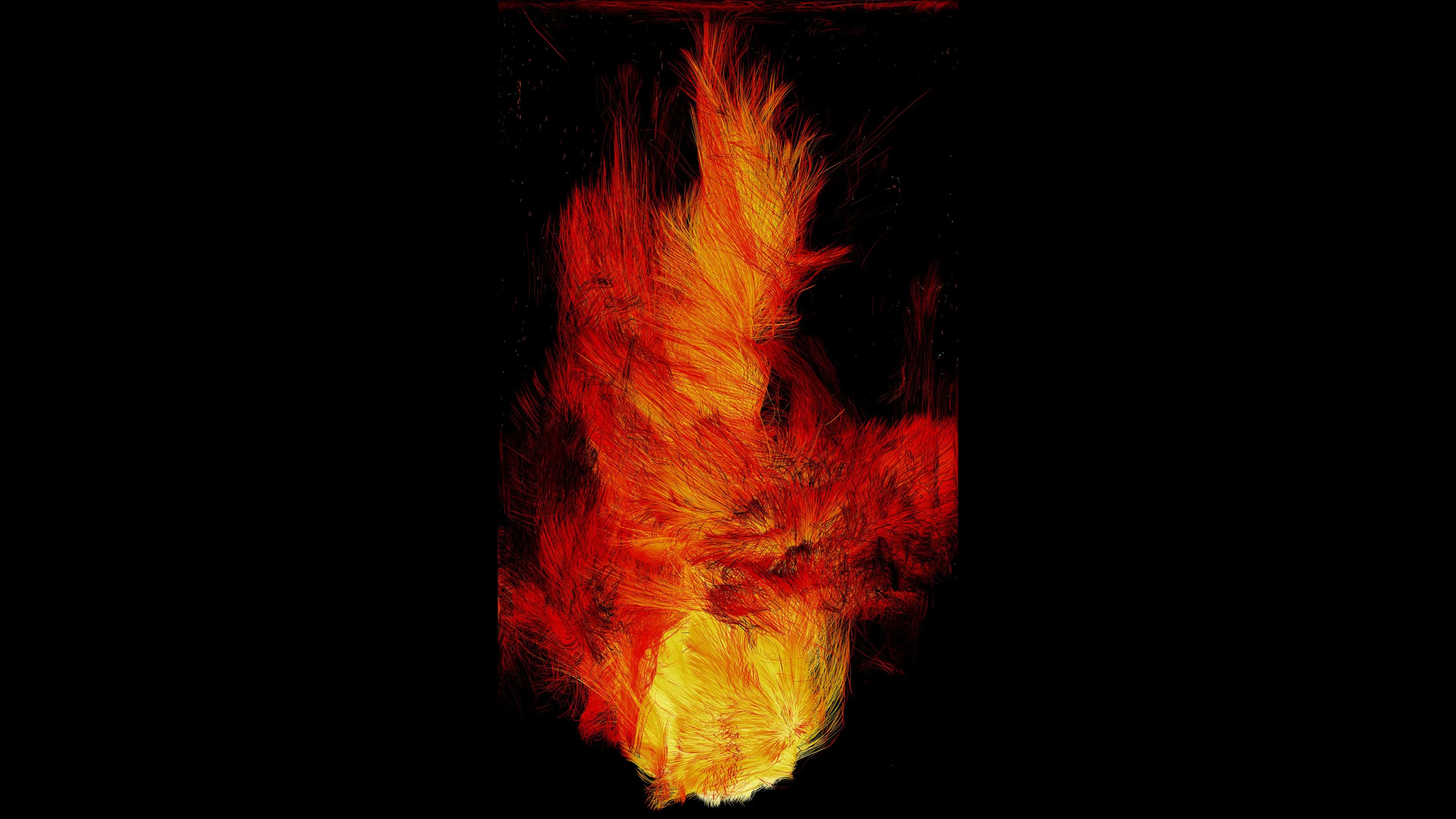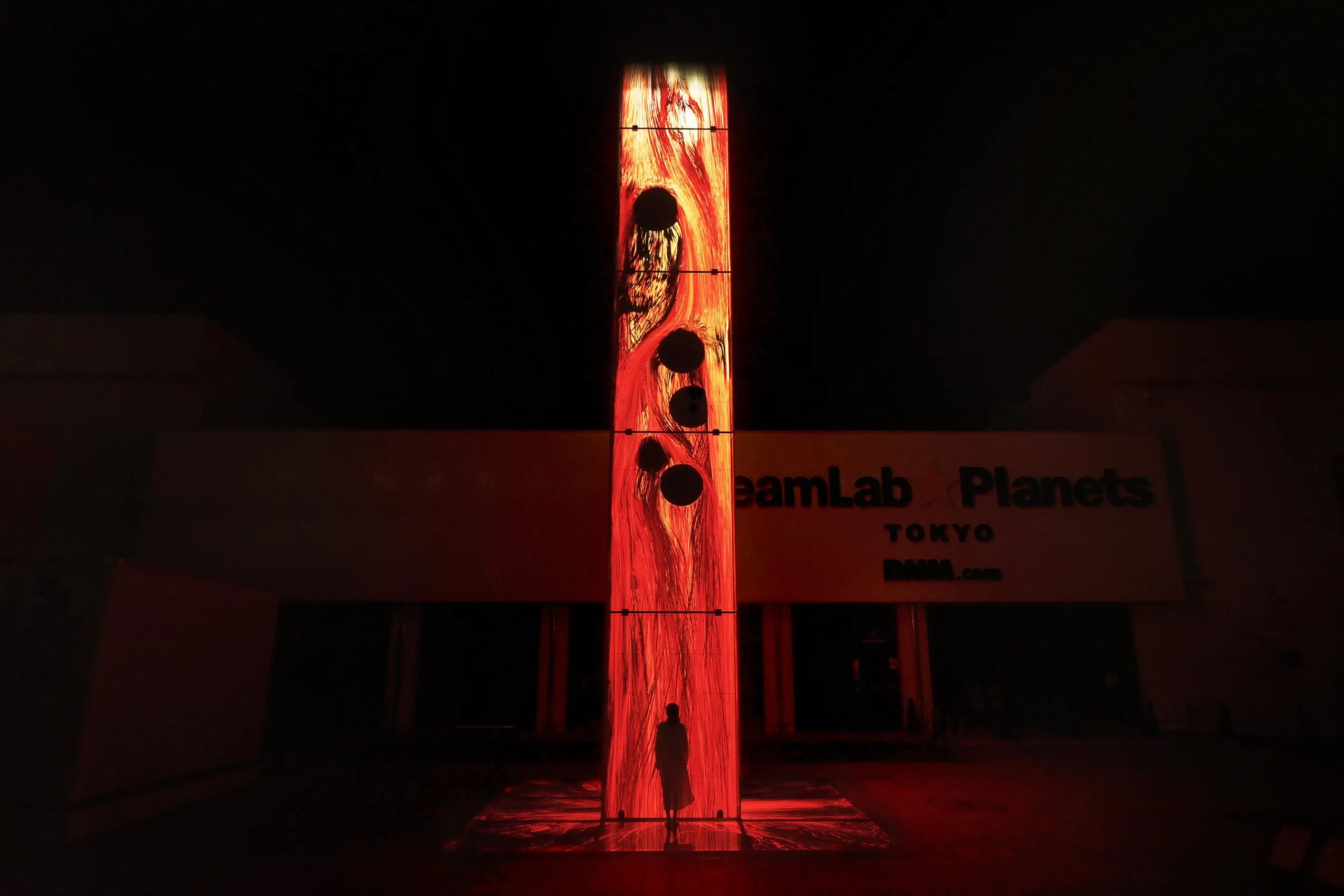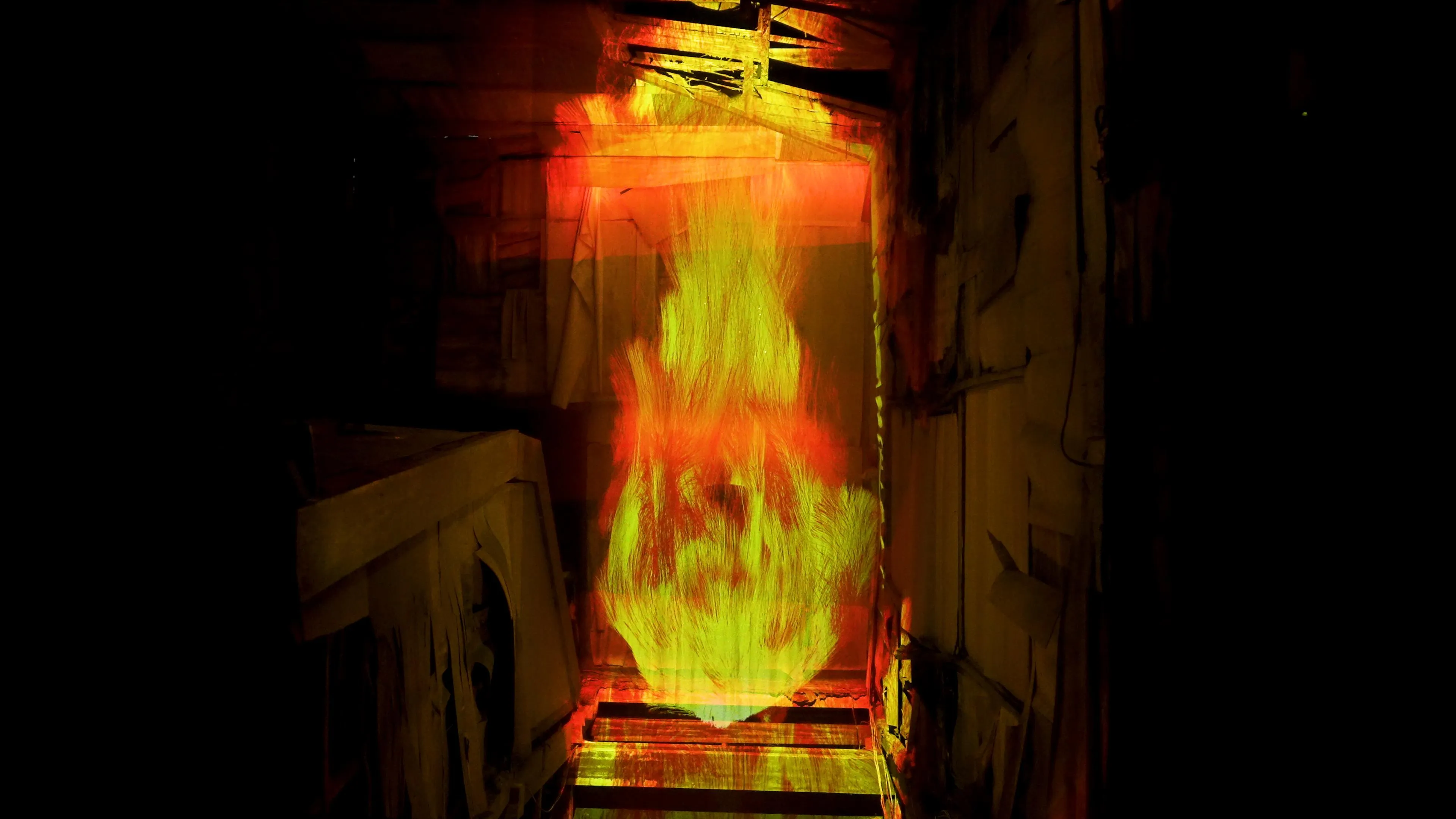
Distributed Art
2021
The artwork duplicates and distributes itself among people. Once the artwork is in the hands of people, it duplicates itself again and is further actively distributed, existing as a decentralized work on people's networks.
When the artwork exists on a network, it will continue to exist even if the original disappears.
FEATURED WORKS

teamLab, 2021, Digital Work, Single channel, Continuous Loop
The flames of Universe of Fire Particles change shape due to a black absolute presence.
Flames are a phenomenon of light and heat generated by combustion; it is a vaporized substance in a flow, a decomposed substance. It is our sensory experience of seeing what is in between phenomenon and substance.
Lines are drawn in relation to the flow of combusting gas, and the flames are created by the accumulation of those lines in three-dimensions. The lines are then “flattened” using what teamLab considers to be Ultrasubjective Space to represent the flames.
teamLab is exploring the concept of Distributed Art.
If you launch the Distributed Fire smartphone application and approach this artwork, the flame will ignite and you can take the artwork home with you. When you bring that flame close to another person's smartphone, a flame will alight. As you connect the flame, and they connect that flame with someone else, the flame will spread all over the world. The flames that are spread are displayed on the Map of The Flame.
Distributed Art duplicates itself, or a part of an artwork is distributed among people. Then, once in the hands of the people, the artwork is further actively distributed, and also makes copies of itself. The artworks will be distributed and exist on people's networks and become decentralized. When the artwork exists on the network, it continues to exist even if the original disappears.
Vedi AltroFlames are a phenomenon of light and heat generated by combustion; it is a vaporized substance in a flow, a decomposed substance. It is our sensory experience of seeing what is in between phenomenon and substance.
Lines are drawn in relation to the flow of combusting gas, and the flames are created by the accumulation of those lines in three-dimensions. The lines are then “flattened” using what teamLab considers to be Ultrasubjective Space to represent the flames.
teamLab is exploring the concept of Distributed Art.
If you launch the Distributed Fire smartphone application and approach this artwork, the flame will ignite and you can take the artwork home with you. When you bring that flame close to another person's smartphone, a flame will alight. As you connect the flame, and they connect that flame with someone else, the flame will spread all over the world. The flames that are spread are displayed on the Map of The Flame.
Distributed Art duplicates itself, or a part of an artwork is distributed among people. Then, once in the hands of the people, the artwork is further actively distributed, and also makes copies of itself. The artworks will be distributed and exist on people's networks and become decentralized. When the artwork exists on the network, it continues to exist even if the original disappears.

Universe of Fire Particles Falling from the Sky
teamLab, 2021, Interactive Installation, Sound: Hideaki Takahashi
When people stand on the work, a black absolute presence is created, and the shape of the flames change. The work is affected by people, and is in a state of perpetual, continuous change.
Flames are a phenomenon of light and heat generated by combustion; it is a vaporized substance in a flow, a decomposed substance. It is our sensory experience of seeing what is in between phenomenon and substance.
Lines are drawn in relation to the flow of combusting gas, and the flames are created by the accumulation of those lines in three-dimensions. The lines are then “flattened” using what teamLab considers to be Ultrasubjective Space to represent the flames.
teamLab is exploring the concept of Distributed Art.
If you launch the Distributed Fire smartphone application and approach this artwork, the flame will ignite and you can take the artwork home with you. When you bring that flame close to another person's smartphone, a flame will alight. As you connect the flame, and they connect that flame with someone else, the flame will spread all over the world. The flames that are spread are displayed on the Map of The Flame.
Distributed Art duplicates itself, or a part of an artwork is distributed among people. Then, once in the hands of the people, the artwork is further actively distributed, and also makes copies of itself. The artworks will be distributed and exist on people's networks and become decentralized. When the artwork exists on the network, it continues to exist even if the original disappears.
Vedi AltroFlames are a phenomenon of light and heat generated by combustion; it is a vaporized substance in a flow, a decomposed substance. It is our sensory experience of seeing what is in between phenomenon and substance.
Lines are drawn in relation to the flow of combusting gas, and the flames are created by the accumulation of those lines in three-dimensions. The lines are then “flattened” using what teamLab considers to be Ultrasubjective Space to represent the flames.
teamLab is exploring the concept of Distributed Art.
If you launch the Distributed Fire smartphone application and approach this artwork, the flame will ignite and you can take the artwork home with you. When you bring that flame close to another person's smartphone, a flame will alight. As you connect the flame, and they connect that flame with someone else, the flame will spread all over the world. The flames that are spread are displayed on the Map of The Flame.
Distributed Art duplicates itself, or a part of an artwork is distributed among people. Then, once in the hands of the people, the artwork is further actively distributed, and also makes copies of itself. The artworks will be distributed and exist on people's networks and become decentralized. When the artwork exists on the network, it continues to exist even if the original disappears.

Universe of Fire Particles in a Decaying Underground Passage
teamLab, 2021, from the series <span style="font-style: italic">Universe of Fire Particles</span>, 2021-, Installation, Sound: Hideaki Takahashi
A long-forgotten underground passage has recently been discovered, and the depths of the passage are decaying. In this space that is crumbling and losing its original structure, a fire burns eternally.
The forest above the underground passage is home to 3,000-year-old trees, and it changes daily with the imperceptible, slow flow of time and with each year passing year, as a space where the endlessly long time accumulates. The ruins from ages past scattered in the forest and the Edo-period garden which remains today each have their own respective space-times. The forgotten underground tunnel is a space where time seems to have stopped, and the depths of the passage are a decaying space and time that will not exist for much longer. The fire that eternally burns there also has its own space and time.
Here, various space-times intersect and overlap.
The fire changes shape due to a transparent absolute presence.
Lines are drawn in relation to the flow of combusting gas, and the flames are created by the accumulation of those lines in three-dimensions. The lines are then “flattened” using what teamLab considers to be Ultrasubjective Space to represent the flames.
teamLab is exploring the concept of Distributed Art.
If you launch the Distributed Fire smartphone application and approach this artwork, the flame will ignite and you can take the artwork home with you. When you bring that flame close to another person's smartphone, a flame will alight. As you connect the flame, and they connect that flame with someone else, the flame will spread all over the world. The flames that are spread are displayed on the Map of The Flame.
Distributed Art duplicates itself, or a part of an artwork is distributed among people. Then, once in the hands of the people, the artwork is further actively distributed, and also makes copies of itself. The artworks will be distributed and exist on people's networks and become decentralized. When the artwork exists on the network, it continues to exist even if the original disappears.
Vedi AltroThe forest above the underground passage is home to 3,000-year-old trees, and it changes daily with the imperceptible, slow flow of time and with each year passing year, as a space where the endlessly long time accumulates. The ruins from ages past scattered in the forest and the Edo-period garden which remains today each have their own respective space-times. The forgotten underground tunnel is a space where time seems to have stopped, and the depths of the passage are a decaying space and time that will not exist for much longer. The fire that eternally burns there also has its own space and time.
Here, various space-times intersect and overlap.
The fire changes shape due to a transparent absolute presence.
Lines are drawn in relation to the flow of combusting gas, and the flames are created by the accumulation of those lines in three-dimensions. The lines are then “flattened” using what teamLab considers to be Ultrasubjective Space to represent the flames.
teamLab is exploring the concept of Distributed Art.
If you launch the Distributed Fire smartphone application and approach this artwork, the flame will ignite and you can take the artwork home with you. When you bring that flame close to another person's smartphone, a flame will alight. As you connect the flame, and they connect that flame with someone else, the flame will spread all over the world. The flames that are spread are displayed on the Map of The Flame.
Distributed Art duplicates itself, or a part of an artwork is distributed among people. Then, once in the hands of the people, the artwork is further actively distributed, and also makes copies of itself. The artworks will be distributed and exist on people's networks and become decentralized. When the artwork exists on the network, it continues to exist even if the original disappears.

